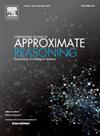用于计算大型数据集的相对约简的相对预约
IF 3
3区 计算机科学
Q2 COMPUTER SCIENCE, ARTIFICIAL INTELLIGENCE
引用次数: 0
摘要
在本文中,我们引入了相对预约的概念,从大型数据集中推导出相对约简。相对约简被认为是一种基于一致性的属性约简方法,通常用于提取条件属性的简明子集。尽管如此,计算所有的相对减少需要大量的时间和内存来构建一个可分辨性矩阵。在本研究中,我们证明了所有的相对预约都可以用一个简化的矩阵来计算,即部分差别矩阵,它可以很容易地转换为相对约简。我们还建议采用数据划分方法来生成差别矩阵。这种方法减轻了每个分区的结果数量增加的问题。这项技术的结果产生了本研究中提出的相对预还原。由于我们对相对缩减计算的增强是独立于其他改进的,因此它们可以与现有方法一起实现。实验结果表明,对于大型数据集,利用相对预约简计算相对约简是有效的。本文章由计算机程序翻译,如有差异,请以英文原文为准。
Relative pre-reducts for computing the relative reducts of large data sets
In this paper, we introduce the concept of relative pre-reducts to derive the relative reducts from a large dataset. The relative reduct is considered a consistency-based attribute reduction method that is commonly utilized to extract concise subsets of condition attributes. Nonetheless, calculating all relative reducts necessitates substantial time and memory to build a discernibility matrix. In this research, we demonstrate that all relative pre-reducts can be computed using a simplified matrix referred to as the partial discernibility matrix, which can be readily converted into relative reducts. We also suggest employing a data partitioning approach to generate the discernibility matrix. This method alleviates the issue of an increased number of results for each partition. The outcomes from this technique yield the relative pre-reducts proposed in this study. Since our enhancements to the computation of relative reducts are independent of other advancements, they can be implemented in conjunction with existing methods. Experimental findings indicate that utilizing relative pre-reducts for computing relative reducts is efficient for large datasets.
求助全文
通过发布文献求助,成功后即可免费获取论文全文。
去求助
来源期刊

International Journal of Approximate Reasoning
工程技术-计算机:人工智能
CiteScore
6.90
自引率
12.80%
发文量
170
审稿时长
67 days
期刊介绍:
The International Journal of Approximate Reasoning is intended to serve as a forum for the treatment of imprecision and uncertainty in Artificial and Computational Intelligence, covering both the foundations of uncertainty theories, and the design of intelligent systems for scientific and engineering applications. It publishes high-quality research papers describing theoretical developments or innovative applications, as well as review articles on topics of general interest.
Relevant topics include, but are not limited to, probabilistic reasoning and Bayesian networks, imprecise probabilities, random sets, belief functions (Dempster-Shafer theory), possibility theory, fuzzy sets, rough sets, decision theory, non-additive measures and integrals, qualitative reasoning about uncertainty, comparative probability orderings, game-theoretic probability, default reasoning, nonstandard logics, argumentation systems, inconsistency tolerant reasoning, elicitation techniques, philosophical foundations and psychological models of uncertain reasoning.
Domains of application for uncertain reasoning systems include risk analysis and assessment, information retrieval and database design, information fusion, machine learning, data and web mining, computer vision, image and signal processing, intelligent data analysis, statistics, multi-agent systems, etc.
 求助内容:
求助内容: 应助结果提醒方式:
应助结果提醒方式:


